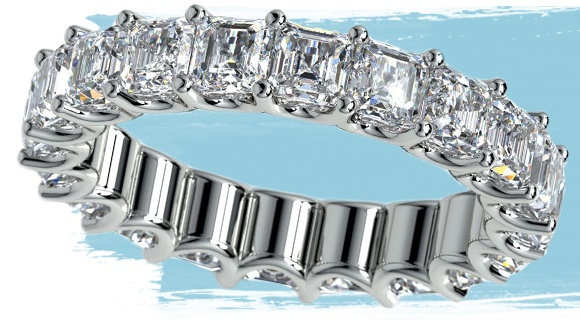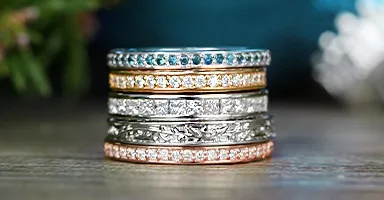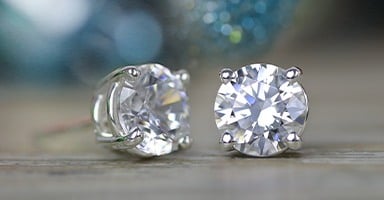Best Settings for Diamond Eternity Bands

Eternity bands are one of the most popular and beautiful options for wedding rings among modern couples. Set with a continuous line of identically cut gems, a diamond eternity wedding band is a grand, glittering symbol of never-ending love. Traditionally, eternity rings were designed to be given as an anniversary gift. Husbands would gift wives with the diamond eternity band on a significant anniversary (such as the 60th “diamond” anniversary). De Beers popularized the ring in the 1960s and marketed it as an option for those who had already selected engagement and wedding rings in the past. Today, however, eternity bands enjoy much greater flexibility, worn by couples (both women and men!) at all stages in their relationship—after all, it’s never too soon to remind someone that your love is eternal. Here’s what you need to know to pick the best eternity band setting for your wedding ring:
General Eternity Band Tips
First off, you should keep certain things in mind at all times when selecting an eternity wedding band. Most likely, you will be pairing this band with an engagement ring, so be sure to select a metal and a setting that will complement the engagement ring. You don’t want them to clash, or worse yet, be physically impossible to wear together. On a similar note, be absolutely certain you have the correct ring size. It is difficult and nearly impossible to adjust sizing when the band is full of diamonds and not more easily pliable metal.
Additionally, because you are selecting a ring with perhaps dozens of tiny stones, protecting your diamonds is a crucial part of the design process. Be sure to choose a setting that encases and protects the stones, guarding against chipping and basic wear and tear. Given the sheer number of stones in an eternity band, you don’t want to end up having to repair or replace diamonds constantly because you picked a beautiful but exposed setting.
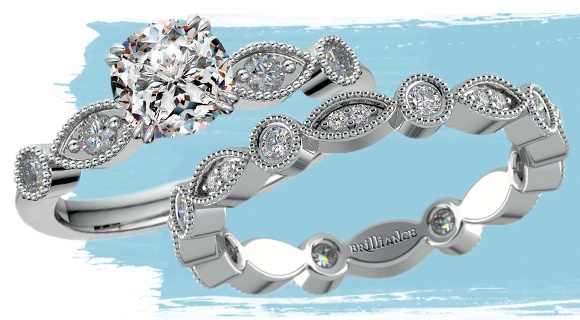
Despite this, remember that the selections are still quite wide when it comes to diamond eternity bands—we recommend four settings below, but within those choices you can choose any variety of styles ranging from floating to trellis to scallop to ivy and more. Choose a protective setting and use the ring style to craft a unique ring that’s true to you and your relationship.
Finally, if the idea of having a full band of stones makes you nervous (or seems cost prohibitive), consider a half eternity band. This places the line of continuous stones only on the top half of the ring, leaving the bottom a plain metal band, which can be good peace of mind for brides who are very active and fear chipping their ring.
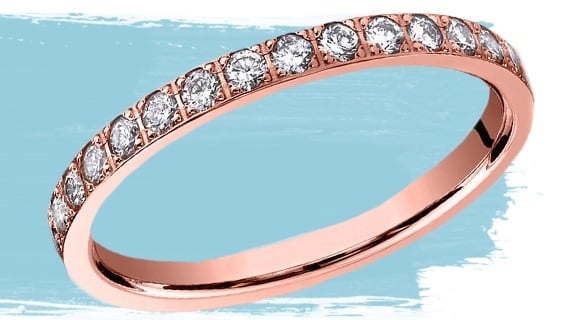
Pave Diamond Eternity Ring
The pave setting comes from a French word “pa-vay,” which means “to pave,” evoking the look of the setting that suggests your ring is embedded with diamonds. In the Pave Diamond Eternity Ring In Rose Gold, small stones are placed close together and the recessed prongs holding the stones in place are minimally visible—this creates the paved effect and increases the brilliance of your ring by creating a look of continuous sparkle. Because the stones in this setting tend to be smaller and closer together, they can often be cheaper because it’s easier to obscure imperfections and smaller carat size in this setting. Generally, this is also one of the safest settings because the recessed prongs keep the stones firm and secure. Just look at a ring very carefully before purchasing as sometimes stones can chip or be damaged if forced too hard into the pave arrangement. This is a great choice for affordability and sparkle factor. This setting is also notable for its combination of brilliance and understatement—if you want an elegant, buts still eye-catching ring, choose a pave setting.

Channel Diamond Eternity Ring
At first glance, the channel setting seems like the most logical choice for an eternity band—stones are mounted between two strips of metal and set in a row all the way along the band. They are also a great choice for those who are very active as the stones are particularly secure and safe from chipping and falling out in a channel setting. If protecting the stones in the band is your primary concern, select the channel setting. Be advised though that they can be difficult to keep clean, and it is the hardest setting to resize without potentially damaging the stones. Also, if you’re looking for major sparkle factor, this is not the setting for you—the high metal walls block out light and reduce the brilliance and shine of the stones. The channel setting is a beautiful and secure design for your band—if you want something simple and elegant, it’s a lovely choice. If you require something more eye-catching, look elsewhere.
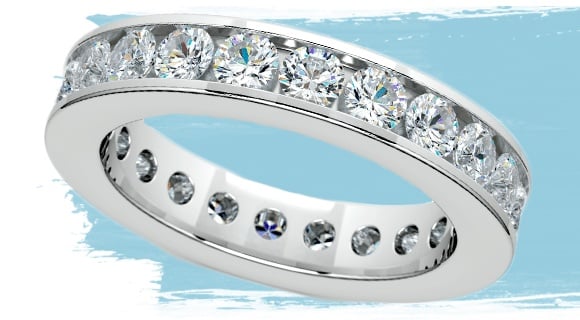
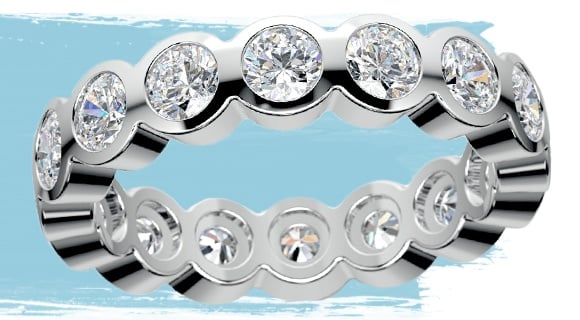
Bezel Diamond Eternity Ring
A bezel setting is the more secure alternative to a prong setting—it encircles the entirety of the stone in metal, protecting it from outside damage. Of all the settings, the bezel is the most secure given its full coverage of the stones—it is the ideal choice for the most active brides or for those who work with their hands. Bezel settings protect the edges of diamonds from chipping, snagging, and more. However, much like the channel setting, the bezel setting blocks out light, thereby reducing the sparkle and brilliance of the diamonds. Bezel settings also tend to be more expensive. If you’re sporty and chic, this Bezel Diamond Eternity Ring In White Gold has the quirkiness in design and security in stone protection to make it an ideal choice.

Prong Diamond Eternity Ring
The prong setting is perhaps both the most vulnerable and the most versatile of eternity band settings. While bezel, channel, and pave settings are restricted to a certain cut of stone and typically favor round cuts, prong settings can accommodate a wider variety of stone cuts, including asscher and cushion cuts. Furthermore, the delicate metal prongs that hold the stones in place allow the greatest degree of light to reach the diamonds, enhancing the bling factor of your ring. So if you want something that really stands out, like this Asscher U-Prong Diamond Eternity Ring In Platinum to the right, a prong cut is the ideal choice. It is also typically the most affordable setting. However, prongs are the most risky choices for keeping diamonds secure—stones are more likely to chip, snag, and fall out of a prong setting. So, if you choose this setting, be hyper-vigilant with your ring to avoid losing or permanently damaging any of the stones.
If you’re willing to forsake security for sparkle, then the prong setting is the best choice for a flashy, eye-catching, gorgeous ring.
